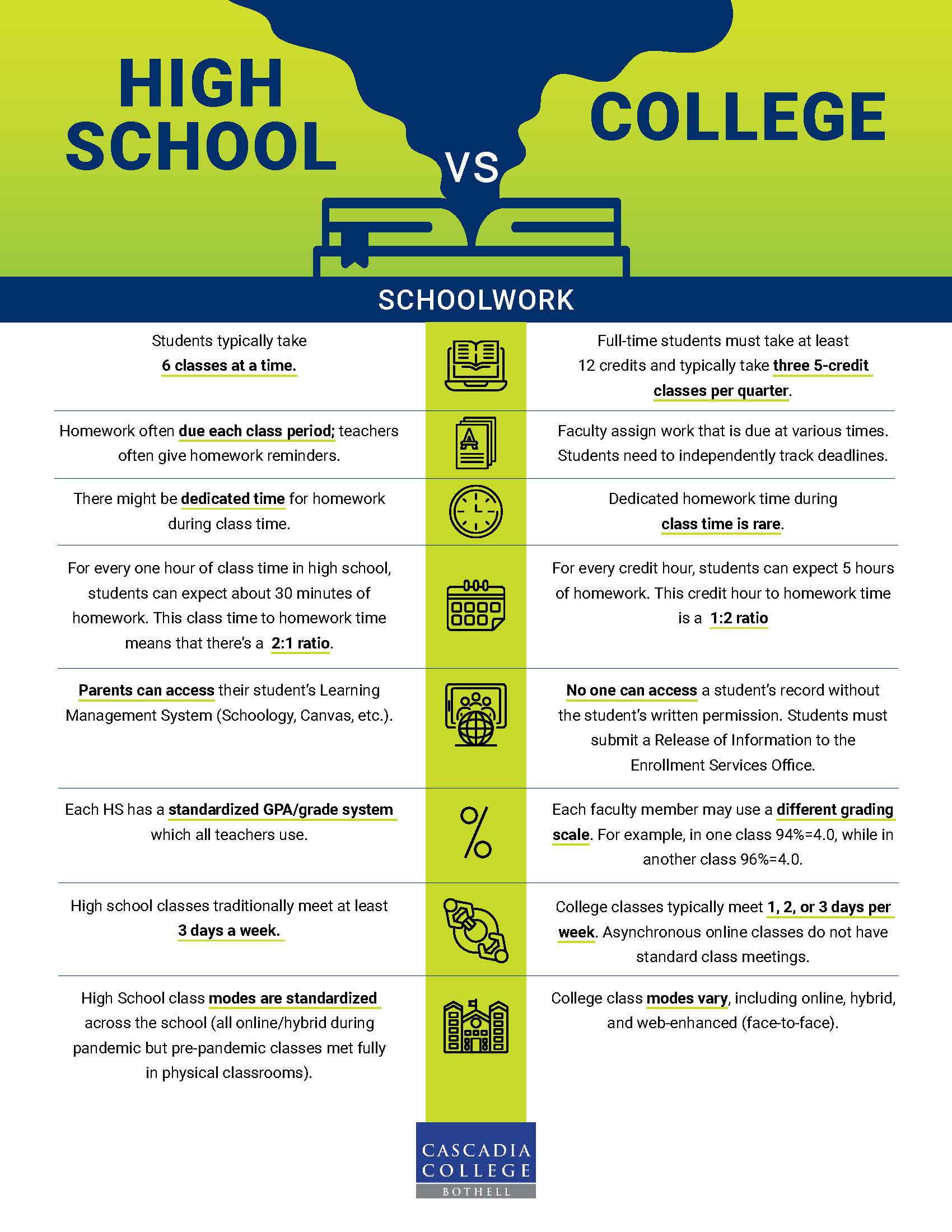4 Differences between High School and College
By Cascadia College Guided Pathways Onboarding Team, 2025
Cascadia College Guided Pathways Onboarding Team


Click Arrow to read the differences in a text format
| High School | College |
|
Schoolwork |
Schoolwork |
|
Students typically take 6 classes at a time. |
Full-time students must take at least 12 credits and typically take three 5-credit classes per quarter. |
|
Homework often due each class period; teachers often give homework reminders. |
Faculty assign work that is due at various times. Students need to independently track without reminders. |
|
There might be dedicated time for homework during class time. |
Dedicated homework time during class time is rare. |
|
For every one hour of class time in high school, students can expect about 30 minutes of homework. This class time to homework time means that there’s a 2:1 ratio. |
For every credit hour in college, students can expect two hours of homework. This 1:2 ratio means that for a 5-credit class, there is about 10 hours of homework in addition to 5 hours of class (in a classroom or online or split between both for hybrid classes) per week. |
|
Parents can access their student’s Learning Management System (Schoology, Canvas, etc.). |
Parents or any family member cannot access a student’s progress without the student’s explicit permission. Faculty and college staff (advisors, enrollment, financial aid) cannot talk to parent/other without student’s explicit permission, on record. |
|
Each HS has a standardized GPA/grade system which all teachers use.
|
College faculty may each use a different percentage to GPA scale. For example, a 94-100%=4.0 in one class, while 99-100% = 4.0 in another class.
|
|
High school classes traditionally meet at least 3 days a week. |
College classes typically meet 1, 2, or 3 days a week, or 0 days if online asynchronous. |
|
High School class modes are standardized across the school (all online/hybrid during pandemic but pre-pandemic classes met fully in physical classrooms).
|
College class modes vary, including online, hybrid, and web-enhanced (face-to-face). |
|
Student Support |
Student Support |
|
Students can often get extra help from high school teachers during class time. |
Students can often get extra help from faculty during faculty office hours. |
|
Responsibility is shared (counselors, teachers, parents, and students). |
Responsibility lies with the student. |
|
High School Counselors offer support with academic achievement, college preparation, post-secondary options, and social/emotional support. |
Academic Advisors offer support with academic degrees, plans, degree options, quarterly planning, transfer prep, and course selections.
|
|
Guardians instigate and manage student IEPs and 504s, which frequently roll over year to year without new documentation. |
Students self-identify and provide medical documentation to request accommodations from Student Accessibility Services. |
|
IEPs/504s focus on success measures. |
Accommodations focus on access measures. |
|
Mental Health Services are contracted through the school district, and students can access a variety of partnering institutions. |
The College Counseling Center offers confidential, professional, and free psychological counseling. All students pre-pay for 6 sessions out of their student fees. |

